Andreas Vogler, Jesper Jorgensen – Windows to the World – Doors to Space – a reflection on the psychology and anthropology of space architecture – 2004
Andreas Vogler, architect, Architecture and Vision / SpaceArch
Jesper Jorgensen, psychologist, SpaceArch
First publication workshop Space: Science, Technology and the Arts in collaboration with ESA/ESTEC, 2004
Abstract
Living in a confined environment as a space habitat is a strain on normal human life. Astronauts have to adapt to an environment characterized by restricted sensory stimulation and the lack of “key points” in normal human life: seasons, weather change, smell of nature, visual, audible and other normal sensory inputs which give us a fixation in time and place. Living in a confined environment with minimal external stimuli available, gives a strong pressure on group and individuals, leading to commonly experienced symptoms: tendency to depression, irritability and social tensions. It is known, that perception adapts to the environment. A person living in an environment with restricted sensory stimulation will adapt to this situation by giving more unconscious and conscious attention to the present sensory stimuli. Newest neurobiological research (neuroaestetics) shows that visual representations (like Art) have a remarkable impact in the brain, giving knowledge that these representations both function as usual information and as information on a higher symbolic level (Zeki).
Therefore designing a space habitat must take into consideration the importance of design, not only in its functional role, but also as a combination of functionality, mental representation and its symbolic meaning, seen as a function of its anthropological meaning. In architecture space-connection interfaces like doors and windows act like ‘sensory organs’ of the building. They allow inside-out communication, but also are elements, which allow the user to control the flow of media, which is light, air (sound and odour), which are communication medias as well as radiation and other forms of energy.
In this paper we will look at the psychological and architectural meaning of these important architectural elements in relation to their extended meaning and importance in a space environment:
Doors: representing the borderline between inner and outer space: mental, physical, and social. In all cultures a division of spaces into multiple layers can be found to divide private and public spaces, sacred and profane spaces etc. Illicit crossing of these borders, as well as their absence can be perceived as strongly offensive.
Inside houses, doors represent the borders between group and individual. The door gives the possibility to withdraw from or come into social spaces. It can also represent a signal of the degree of openness the inside individual as for outside communication. By looking on the meaning and functionality of doors we will suggest different models for designing doors in space habitats, due to its functional and social function.
Windows: relate the human being to the outside and give the possibility to explore the outer world from within a safe home. Since Gagarin the importance of seeing the earth, while living in space has been observed.
In this paper we would like to advocate for a closer connection between architecture, anthropology and psychology in designing space habitations, as a part of a new concept of environmental design strategy in space habitats.
Introduction
Many current space habitat designs are driven by the limitation of pressurized volume and rocket diameters. This often results in the complete neglect of the architectural and sociological zoning of the space habitat. As much professional care and detail is given into the engineering problem of having the spacecraft in orbit and keeping the humans alive, as much neglect is given to basic architectural and psychological issues, which, if known at the beginning of the design process, would even reduce costs and could contribute to the development of space habitats which are more than inhabited machines. Also near future missions to Moon or Mars will be temporary. A human Mars mission must be designed on insights into how the human being lives best in a very extreme situation. Psychological factors will be more important than ever in spaceflight. The well-selected individual military test pilot will be succeeded by an experienced scientist with a high social intelligence, allowing him to live and interact with other astronauts in a confined and isolated environment over long time. Psychological factors have in the recent years been more and more important in preparation studies for a long-term planetary mission (CPA, Humex) In some studies weighed as the most important factor. Simulation studies have supported this views, as ex. The SFINKSS study in Moscow.
The connection of the human being and space is very profound. All our sensory organs are in constant relation to the space around us. We put our own body’s dimension into relation to the space surrounding us and developing a sense for scale and proportion. We meet other people in space, which makes it social and communicative. Philosopher Immanuel Kant for the first time relates space to the human being. Gauss goes even as far as denying the very existence of space outside our thinking. The existence of an outer world experienced in relation to our inner world occupied philosophers and artists the like. As space cannot be perceived without motion, and movement in space cannot be controlled without the brain, the development of the brain in evolution is closely connected to space. In sociology space is divided into public, semi-public and private, which reflects our cyclic psychological need for these states of being. Territorial behavior for the human being is more than protecting the physical space, it is important for psychological health. Territorial control by conquering common space to convert to personal space can be a way to gain control in the group. Packing common rooms with individual lab equipment could be a way to do this control. The size and construction of this personal space, which can be seen as the intra-personal space, is both a mental and physical factor, is a variant from individual to individual. Too, the cultural systems have different normality of the size of personal space. (Ex. This can be observed in the way we are cueing up in different cultures: some with persons very close to each other’s, other with a distance of up to a meter between the individuals)
Architecture is the profession of creating and structuring habitable spaces. Architecture is using structural elements to define spaces, organize them and create a ‘place’. The education of the architect is deeply based on an understanding of space. Space in its functions, its technology, but also in its psychology, sociology and meaning. It is also the profession, who is organizing all the consultants and specialist by the design, at least on Earth. In the design of space habitats, this is so far poorly recognized. Whereas the engineers, who are designing habitats are often confused by the contradicting theories of e.g. psychologists and the multitude of options and ‘soft requirements’, the architect is by its profession very used to that. The Architect has, next to the technical expertise, a deep understanding of the elements ‘vagueness’, the ‘blurred’ and the multiple meanings of inhabited spaces.
The architecture of inhabited spaces
Architecture is creating functional space, but as multi-layered and complex the human being is, as multi-layered and complex is functional space. The architect is trained to consider at every moment of the process the physical, perceptible, psychological and sociological space. All these layers constantly overlap and a change of one element often involves a change in the whole system. Kenneth Rexroth describes Ecology as the science of the togetherness of living things and their environment [1]. This was in 1963, when environmental sciences just started. Nevertheless the analogy evokes the complexity and interdependency of the space habitat. When we start thinking about space habitats in terms of ecologies, we may shift our systems thinking more towards the maintenance of active balances than trade-offs of mass budgets and hard versus soft requirements. An ecological system is as strong as its weakest element.
The Human being is living in a balance of privacy and community, which is always pushed and counteracted. In most cultures it still seams the most powerful punishment to deprive people from free movement in space and social contacts. Space is structured and has hierarchies. All cultures of the world have founding myths, when new houses are built or cities founded. By a conscious religious act order in space is created. Man defines its position in the cosmos by symbolically re-creating the center of the world, by bringing order into chaos [2]. Many of these rites survived even in the enlightened western culture like the act of laying a foundation stone, often with document inside it. Many cultures also do have a strong emphasis in the orientation to the east, where the light comes from, where the world is reborn every morning. Inhabiting a space is an act of taking control. Home is the place, where one has the feeling of control over the environmental influences like wheater, temperature, wild animals etc. and the social influences like strangers, visitors, friends etc. The act of taking control and the feeling of having control is directly linked to our psychological state of being.
It helps the architect as the organiser and designer of the spaces to operate with the awareness, that space has more than its three geometrical dimensions. The given technological reality is forcing space habitats to be near the extreme end of physiological space. Some space habitat designs tend to take this extremeness as an excuse to ‘ignore’ the other layers completely. This is supported by the fact, that human factor requirements are often considered as ‘soft requirements’ as opposed to the ‘hard requirements’ of life support systems and structural integrity. If there would be more interdisciplinary and integrated planning teams, one would make the experience, that especially the soft requirements often do not cost extra in hardware, but may prove to be indispensable in long-duration spaceflight.
The authors suggest 4 main layers of space: 1. Physiological space as the spatial environment we need to physically survive, 2. Perceptible space as how our senses interact with space, 3. Psychological space as how we project and reflect our inner self to the outside space and 4. Sociological space as we define zones of privacy and community. All layers overlap and find there expression in the eventually built environment and the way it will be inhabited.
Physiological Space
Physiological Space is the space to provide physical survival and the dimensional needs for work and rest. It needs to provide structural integrity and protection against the environment and maintain an interior environment within a certain comfort box. The construction of space is driven by functional requirements, technological possibilities, costs and time, and the conceptual intention of the architect. The physiological, functional space height in most terrestrial habitats is between 2,10 and 3,00m, sometimes more to allow for air circulation and/or production machinery. This spatial layer can be subdivided into functional areas, which creates spatial sequences. The spaces have to be connected in a way to allow for transportation of equipment and escape routes.
Perceptible Space
The connection of the outer to our inner world and vice versa is happening by our senses: Taste, smell, touch, vision, and hearing. The human senses, as opposed to technical sensors, are guided by experience and culture; the way we perceive things is strongly dependant on our personality, our cultural background and our psychological health. The range between acceptable and unacceptable is fairly wide and the difference in the perception of e.g. noise and odor can already lead to tensions within a group. The main psychological problem in long-duration spaceflight is sensory deprivation due to Restricted Environmental stimulation (RES). A richness in the way the individual can perceive spaces should be sought.
The most substantial exchange with our environment we have by food and our sense of taste. Although different to the other four in the sense, that taste is not in a direct relation with spatial perception, it has an important influence on the psyche, our inner space. It is reported especially from military how immediately spirit lifting good food is even in the hardest situations. To control odor in the space habitat is very demanding and puts a high demand on the tolerance of the inhabitants. Activations of senses could happen with scents. Noise of the ECLSS machinery will govern every space habitat. There should be strategies developed, which allow to stop the machinery for limited amounts of time to go into a silent mode. This may be easier on surface habitats, than under microgravity conditions, where a natural airflow cannot be achieved. This would allow the crew to listen to the wind of Mars, but also to the low level noise like the cracking of the habitat through temperature expansion in the morning. Changing everyday noises often makes people realize potential problems in structure or machinery, which is an important safety aspect. Further audible privacy needs to be provided, for communication with audiovisual family (if possible), but also for private discussions between crewmembers. If not, EVA suits and their radio system may be misused to do so.
Visual control of the space habitat seems to be the most obvious and terrestrial architecture is rich in strategies to influence the perception of space by light, colour and geometry. Much can be done in making a small space appear bigger and wider. An important influence on visual control has housekeeping discipline and the organization of storage. A higher than usual design attention needs to be on surface and things we touch, like door handles. There should be a richness and clear hierarchy on hard and soft materials, on flat and structure surfaces.
Psychological Space
The psychological criteria for a human habitat can be described as identity, stimulant and safety, leaving the counter-criteria anonymity, boredom and anxiety[3] Without active countermeasures a space habitat fits perfectly the counter-criteria. The space needs to allow for self-reflection and self-projection. There needs to be a visual order and clarity to allow for that. We know from metal sickness, that unclear and messy spaces are counterproductive. Stimuli should be by changing conditions of light during the day and the occurrence of unexpected, but friendly things. The feeling of safety is a very critical issue, since, if once lost like through an accident in an early mission state, it is very difficult to reestablish it. To have the feeling of control in your habitat is a highly important component. The very act of ‘inhabiting’ space can be compared to taking control. In the early days of US spaceflight, astronauts had to fight for a window, which was considered an engineering risk factor. The window and its connection to the outside world, after all, allows the astronaut to position him/herself in space and gives a feeling of control. Airlines have clearly understood the problem of giving away control in a potentially unsafe environment. With a careful interior design, indirect lighting, but also with the whole system of serving drinks and food, showing movies and caring with flight attendants they create this feeling of identity, stimulants and safety in a environment, where one is handing over the complete control to somebody else.
Sociological Space
The individual need for privacy requires barriers and physical insulation as well as the need for togetherness requires correspondent and clearly defined spaces to create a secure feeling of home. The architect works with 3 zones, which are public, semi-public and private. The private space has to be considered both as group-private or individual-private. The functions of physical spaces can change and overlap during the day. The kitchen, which would be a public space in a space habitat, could become a group-private space, when two crewmembers hold a private conversation, which could be communicated to others outdoor by a lower voice. These barriers are not only physically defined but culturally, one with a ‘good education’, would not just intrude into the kitchen, but knock on the door or come again later.
Door and windows are very important elements in switching these spaces and communicating the social openness of the space. Much of the complexity of architectural spaces and the interaction of the elements has been brilliantly documented in the book “A Pattern Language” [4]. Fig. 1. shows a diagram of the spatial organization of a habitat, which is identified as one of the pattern. In contrast Fig. 2. (courtesy of NASA) shows the current state of the Zvezda Module of the International Space Station, which is basically expressing, next to the difficulty of keeping order in a microgravity environment, the tremendous improvement possibilities, once the designers are thinking beyond pure mechanical spaces. The image also shows how the human being is just trying to inhabit the space. Notice the Icon of Virgin Maria on top of the ‘door’.
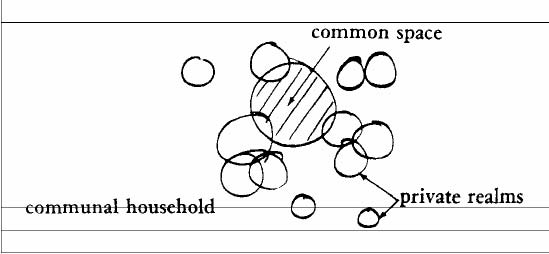
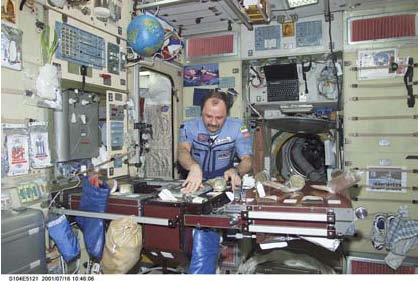
Probably a layer of its own right is symbolic space, which describes meaning we perceive and give to spaces.
“In our everyday life we experience not solid and immediate facts but stereotypes of meaning. We are aware of much more than what we have ourselves experienced, and our experience itself is always indirect and always guided. The first rule for understanding the human condition is that men live in secondhand worlds.
The consciousness of men does not determinate their existence; nor does their existence determine their consciousness. Between the human consciousness and material existence stand communications and designs, patterns and values which influence decisively…” [5]
Privacy and community
“Man creates his own environment… Create is hardly the word, so far as he has simply made it, in the sense we say; »Well, you’ve made your bed, now you have to lie in It. [6]
Serge Chermayeff and Christopher Alexander describe in their seminal work “Community and Privacy” the need for filter zones between communal and privat areas. This basic zones, where social behaviour translates into architecture were seen in danger with the growing emphasis of functionalism and technology in modern architecture. The growth of the city population in the 1960ies led to unpersonal ‘living machines’, which where denoted by monotony, boredom and anonymity. The neglection of basic zoning led to a fast decay of some large scale housing scheme like the famous Pruitt Igoe, which had to be destroyed after only 16 years since crime and devastation took overhand. [7]
The human being has to be understood as being in a fruitful balance between community and privacy. The more lively this balance is, the better. Usually an architect would layout the private and communal rooms. The most important, but often neglected, infact is the transition between the two, the in-between zones. The hierarchy of the domains and the domains themselves need to be clearly supported by the design, as well they must not be intrusive.. To make the transition between private and public, the astronaut should have maximum variation, choice and control. “We might therefore take as our general picture of the universe a system of continuity in which there are two elements, randomness and organization, disorder and order, if you like, alternating with each other in such a fashion as to maintain continuity”. [8]
Most discussions of long-duration space missions tend to recommend private quarters for each astronaut. Harrison identifies 3 ‘functions’ of privacy [9]: 1. Undistracted work, 2. rest and recuperation and 3. control of self-image projected to others (‘getting off-stage’). Further he identifies the need for group privacy for intimate discussion, venting emotions, and providing critical performance feedback. The need for privacy is counter-balanced by the need for community, for being with and interact with other people. The interaction with people is a important factor for emotional reassurance, for stimulants by discussion or unexpected action and sharing emotions.
Most discussions of long-duration space missions tend to recommend private quarters for each astronaut. Harrison identifies 3 ‘functions’ of privacy [9]: 1. Undistracted work, 2. rest and recuperation and 3. control of self-image projected to others (‘getting off-stage’). Further he identifies the need for group privacy for intimate discussion, venting emotions, and providing critical performance feedback. The need for privacy is counter-balanced by the need for community, for being with and interact with other people. The interaction with people is a important factor for emotional reassurance, for stimulants by discussion or unexpected action and sharing emotions.
Considerations for the use and design of doors and windows in a space station or surface habitat
« Space isn’t remote at all. It’s only an hour’s drive away if your car could go straight upwards. » [Sir Fred Hoyle, « London Observer, » 1979]
Origins of the word window and door.
window – 12c, from O.N. vindauga, from viondr « wind » + auga « eye ». Replaced O.E. eag?yrl, lit. « eye-hole », and eagduru, lit. « eye-door ». Orginally an unglazed hole in a roof, most Gmc. languages adopted a version of L. fenestra to describe the glass version, and Eng. used fenester as a parallel world till mid-16c. Figurative meaning « time period when something may be accomplished » first recorded 1967.
door – represents M.E. merger of O.E. dor (neut.; pl. doru) « large door, gate, » and O.E. duru (fem., pl. dura « door, gate, wicket »), both from P.Gmc. *dur-, from PIE*dhwer-/*dhwor – « a doorway, a door, a gate » (cf. Gk. thura, L. foris, Gaul. doro « mouth », Goth. dauro « gate », Skt. dvárah « door, gate, » O.Prus. dwaris « gate », Rus. dver’ « a door »). The base form is a frequently in dual or plural, leading to speculation that houses of the original Indo-Europeans had doors with two swinging halves. M.E. had both « A door is what a dog is perpetually on the wrong side of. » [Ogden Nash]
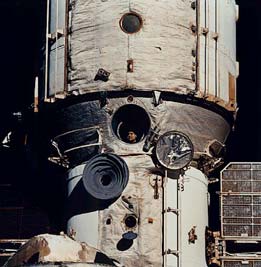
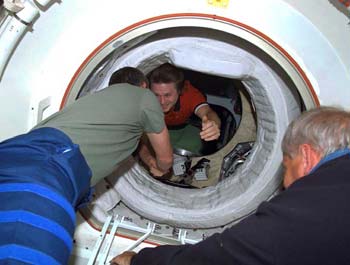
Outside Doors
The door is one of the most active architectural elements. It controls the connection between inside and outside. Technically the door has to allow the connection of two different environments, with mostly different conditions in temperature, air pressure, humidity and so on. But is also has to provide safety and protection from noise, visual pertrusion, fire and people. The door is a place of control. Somebody controls the door to be opened or closed, to enter somebody elses space. Like no other element the door is associated to the protection of privacy. To enter a house or an apartment for investigations, the police needs an official inquest. Nearly each state is protecting the threshold between public and private by law. To be able to control a door, to control access to space is one of the daily supports of self esteem and self-convidence. Not without reason, the human being invented prisons for punishement to exactely take that control away. This point is very important for long-duration missions and supports the idea of individual crew quarters. The outside door in space will be a docking module (Fig. 5.) or an airlock, which both form new architectural archetypes of a spacefaring civilization. Next to their technical complexity, there will be new meanings associated to them. Fig. 4. showing Cosmonaut Valeriy V. Polyakov, who spend over a year on the MIR space station, during rendezvous operations with the Space Shuttle Discovery. This image evokes the feelings of loneliness, joyful expectation of community and togetherness and the concept of ‘home’.
But the door is more than a ‘switch’ or a mere treshold, it is a space in its own right, a space of transition and a ‘place’ of decision. It is the place, where you make the decision, if you let somebody in or not, the place where you learn about another person. It is also a place saying good-bye to your hosts, wishing them farewell. Many emotions about social interactions are connected to spatial thresholds and doors. At doors, the state of our life is changing from what we have done before to what we will do in future. It is a transition from the past to the future. Not without reason the Roman god Janus was the genius of the door. Further the door is a space of activity, of movement of potential social contacts. It is a well known image of people sitting in front of a door (Fig. 6.), especially in southern countries, where the climate is more supportive. In this state a person is on one hand protected by the private space in the house behind, which can be easily access in case of weather changes or social withdrawel. But, out of this position of security one takes part on the public life of the outside, where people pass and social contact is possible. This very important social state of being ‘semi-public’ can already be observed in the smallest habitats like the Mars Arctic Research Station on Devon Island, which is an analogue surface habitat. In a afternoon working period, some of the crew members chose to set up their chairs in front of their open crew quarter doors (Fig. 7.). This position allows them to take part on the community, but also to retract into their crew quarter without causing major attention in the group, whereas somebody getting up from the table is causing more social attention. It is interesting to note, that already by the position in space, the state of ‘semi-public’ is communicated to the others.
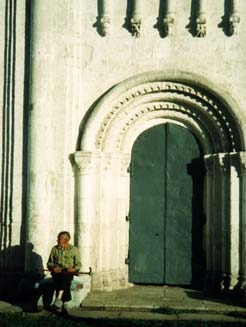
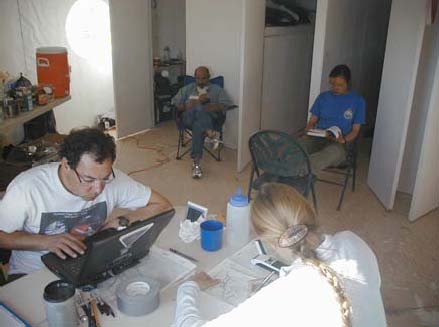
Inside Doors
The space habitat is a world of its own. When we go to space we have to take everything with us, starting with the oxygen and water. What we also will take with us are patterns of behaviour and our ability of giving things meaning. But this will also mean, that we will interpret meaning into things. For the designer this means to allow as much meaning for the elements in a space habitat as possible. It has to be understood, that in a space habitat, the crew quarter door will also overtake functions and meanings of the outside door. It is an element of control and a signal of the degree of openness for community. The door can become a potential media for unspoken communication, signaling the wish for privacy of the person in it. Table 2 shows the relation of the position of the crew quarter door to a potential state of the inhabitant. Undoubtely in a long-duration mission the crew will develop certain habits. This could be for example, that at the beginning of a mission crew quarter doors are generally left open. If weeks later a crew member starts to close the door, this may be interpreted as an offensive act against the group. On the other hand in a situation where the group tends to maintain more privacy, a crew member leaving the door ostentatiously open, may disturb others in their perceived privacy in the public and semi-public spaces.
Architecturally, doors and inner windows can strongly influence the appearance of the space. An appartment usually looks dramatically smaller if all doors are closed compared to when they are all open. The door has some ergonomical functional aspects. Can it be opened when carrying something (e.g. with elbow and foot) or do I need to have a hand free? Does it open and close automatically? What states of openness does it allow? A quick study shown in Fig. 8. and Fig. 9 shows, that in the given case a simple swing door provides actually a higher state of visual privacy during different degrees of openness.


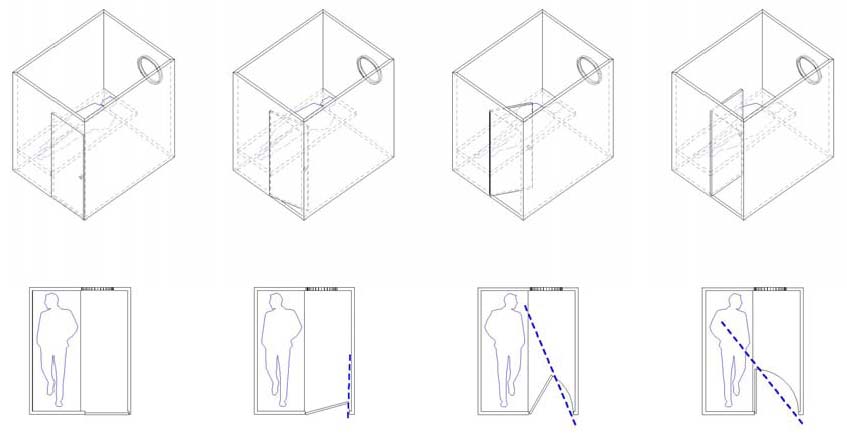
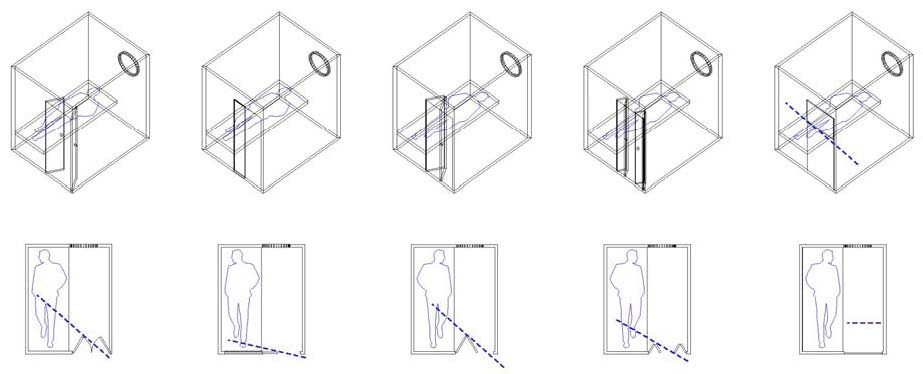
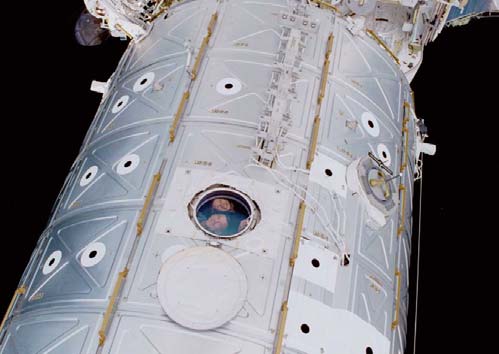
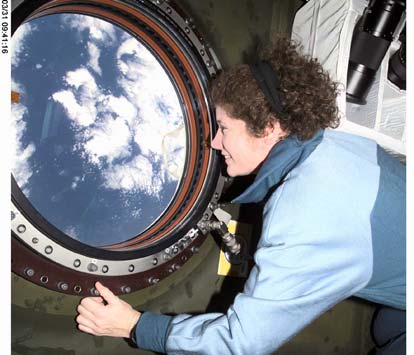
Outside Windows
Different than the door, the window is a place of reflection and of projection. Looking through a window we are usually in the protected and controlled inside space. From this comfortable condition we can look out, observe or just connect our inner self to the outside world. The window frames the view and makes it controllable. It is reported from many astronauts, that they like to spend every free minute on the window gazing on the Earth. Especially astronauts, who had longer stay on space stations reported about how to look on to the blue planet ‘connected’ them to their home (Fig. 10 and 11).
This important psychological role of the window is in stark contrast to the resistances against windows in spacecrafts. For the engineer the window as a penetration of a pressure vessel is a structural problem. For the administrator it is still today a cost problem. Tom Wolfe points out in his book ‘The Right Stuff’ [11] how the first astronauts, who were mainly military pilots, had to fight for windows. Even if a spacecraft was completely controlled from ground, pilots, who are used to control their flights, showed a strong resistance against ‘being shot up in a rocket like an ape’. But the window proofed to be the actual live safer on Apollo 13, where for a short time the spacecraft had to be navigated by visual control through the window. Also Industrial Designer Raymond Loewy reports how strongly he had to fight against resistances of the engineers to windows in the first American Space Station Skylab.
The real window is a space, compared to the virtual window or the painting, which can also support self-reflection and self-projection. The frame and the amount of outside seen is changing by movement. It is a place, where people spent time, where they connect to the outside world. The image of the old person spending the day looking out of the window is a well-known archetype (Fig. 12). The window also brings light into the house, thus reflecting the changing conditions from the outside inside. The painting by Edward Hopper ‘Morning in a City’ is also expressing, how the window is an element, which can connect privacy directly to the outside. With the distance to the window there is a choice and different degrees of seeing and being seen.
On surface habitats windows should be located the way, that they allow a 360 degree visual connection to the outside. They must allow a visual connection to the outside for a intuitive registration of the outside condition, the weather and the daytime. The incoming sunlight should enrich and change the appearance of the spaces during the day.
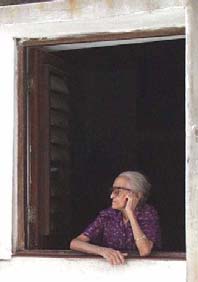
Inside Windows
Windows are offering a connection to the outside world, without the possibility for a physical connection as with a door. A window is a quiet place, contemplative, not an exposed through-space as a door. Although the few portholes in orbital space station where constantly used by astronauts to watch the Earth, gazing out of a spaceship which is on the passage to Mars can become very boring, or in case of rotating artifical-gravity spacecraft, a visual challenge. On a surface habitat outside windows will be very important, nevertheless the hermetic inside space can be enriched by introducing ‘window’ connections between private space and public spaces. A window, which can be opened and shut for acoustic control and a blind for visual control, can give many possibility in a confined environment. Constance Adams points out, how this concept of crew quarter windows was introduced in a design improvement of NASA’s BIO-Plex design [12]. Several other design improvements have been made to enhance this in-between zone between public and private.
With such a window a crew quarter could be orientated to the common room during day time. The window can have a shutter blocking light as well as signaling the state of privacy of the crew member. The very limited amount of available space is pressing for new ideas how private zones can be secured, but how spaces can change to – at least visually – allow more space. Following this concept architecture, student Johannes Talhof developed with the studio of Professor Richard Horden at the Technical University in Munich the concept of a revolving workstation (Fig. 16), which either can be operated from inside the Crew quarter in a fairly private condition or, alternatively during daytime, it can be turned by 90 degree allowing a comfortable working condition between the privat and public space, reflecting exactly the behavior of the crew in the Mars Arctic Research Station shown in Fig. 7.
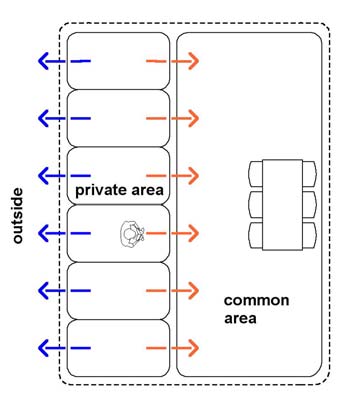
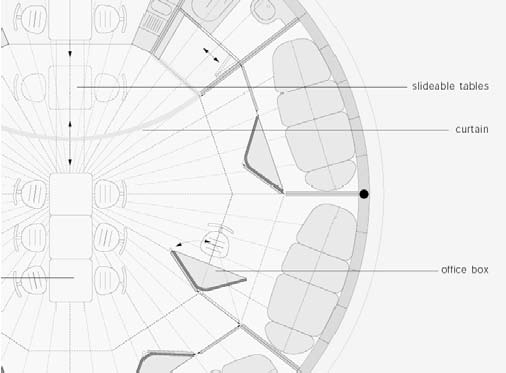
Conclusions
The investigation into such simple architectural elements like door and window from a more architectural and integrated view point than a pure technical aspect, unveils how closely connected spatial elements are to the human behaviour and the active support of the balance of the ‘ecological’ system of the habitat. Spaces have to be planned for choice, flexibility, but also more so for privacy and the feeling of control of the individual. It is important, that this relevance is known at a very early state of the design process, where by the basic layout of a space habitat many opportunities for a cost-effective improvement can be given away. Still today, the ‘experts’ are integrated – if at all – too late in the design process. The architecture of a space habitat requires an interdisciplinary design approach, which means theintegration of the findings of psychology, sociology as well as ergonomics and Life Support Engineering.
References
[1] Rexroth, K., Foreword for Chermayeff, S., Alexander, Ch., Community and Privacy, Doubleday & Company, Garden City New York, 1965
[2] Eliade, M., Das Heilige und das Profane, Kap8. “Die Erschaffung der Welt übernehmen”, (engl. The Sacred and the Profane: The Nature of Religion), Rowohlt, Hamburg, 1957, revised edition: Suhrkamp, Frankfurt a.M., 1990
[3] Weichinger, R., Schulz, W., Graefe, G., “Kriterien der Wohnungsgestaltung”. Forschungsarbeit für das Bundesministerium für Bauten und Technik, Wien 1973, p. 575
[4] Alexander, Ch., Ishikawa, S., Silverstein, M., A Pattern Language, Oxford University Press, New York, 1977
[5] Mills, C.W., The Man in the Middle in Design and Human Problems, 1958
[6] Rexroth, K., Foreword for Chermayeff, S., Alexander, Ch., Community and Privacy, Doubleday & Company, Garden City New York, 1965
[7] Von Hoffman, A., “Why They Built the Pruitt-Igoe Project?”, Joint Center for Housing Studies, Harvard University (10/05/04)
[8] Young, J.Z., Doubt and Certainty in Science, 1951, Reith Lectures, 1950,
[9] Harrison, A., Spacefaring, University of California Press, Berkeley and Los Angeles, 2001, p. 87-88
[10] Online etymology dictionary, https://www.etymonline.com
[11] Wolfe, T., The Right Stuff, Bantam Books, New York, NY, 1980
[12] Adams, Constance M. (1998 July). “Four Legs in the Morning: Issues in Crew-Quarter Design for Long-Duration Space Facilities” (SAE 981794). 28th International Conference on Environmental Systems (ICES), Danvers, Massachusetts, USA, 13-16 July 1998. Warrendale, Pennsylvania, USA: Society of Automotive Engineers
© Andreas VOGLER & Jesper JORGENSEN & Leonardo/Olats, mai 2004, republished 2023
Leonardo/Olats
Observatoire Leonardo des Arts et des Techno-Sciences
À propos / About



Pour toute (re)publication, merci de contacter / For any (re)publication, please contact Annick Bureaud: info@olats.org
Pour toute question concernant le site, merci de contacter / For any issue about the website, please contact: webmaster@olats.org
Design Thierry Fournier
© Association Leonardo 1997-2022